I see you – leaning halfway out of your seat before the plane lands so you're ready to grab your...
What do the Lumo Delay Indexes mean?
The Lumo delay indexes are a score from 1 to 10 given to each flight indicating how “risky” a flight is with respect to being delayed. The score is intended to capture both delay frequency (probability of a delay occurring) and delay severity (how long will the delay be if it does happen).
Quite simply, a delay index of 1 indicates near-certainty of less than a 30-minute delay, while an index of 10 indicates near-certain delay of 2 hours or more; the numbers in between are essentially a weighted average of the likelihood of a delay of different magnitudes.
Lumo calculates this index as a weighed average of 4 numbers:
- The likelihood of a delay of less than 30 minutes (p0)
- The likelihood of a 30-60 minute delay (p1)
- The likelihood of a 1-2 hr delay (p2)
- The likelihood of a 2+ hour delay (p3)
A delay index of 1 corresponds to the case when the first bucket (p0) is close to 100%. A delay index of 10 corresponds to the case when p3 is close to 100%. A certain delay of at least 30 minutes results in a delay index of 6.
Here’s a breakdown of the delay index 16 hours out vs the average delay for 1 year of flight data. Obviously, these are averages and your specific situation might be different..png?width=764&name=Lumo%20Master%20Deck%20API%20(1).png)
Here's one example of the predictions.
At 12 hours before departure, Lumo alerts the traveler that winds at LGA could disrupt their flight, and assigns a delay index of 5 (there is a 60% chance of less than a 30-minute delay at that point).

Subsequently, as conditions evolve, Lumo upgrades the prediction to a 7 (only a 25% chance of less than a 30-minute delay).

The flight eventually ends up being significantly delayed (since there is a 100% chance of a 2+ hour delay at this point, the delay index would be 10).

Here is another help page on the delay indexes and a blog post on the factors that go into our predictions.





